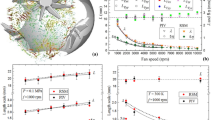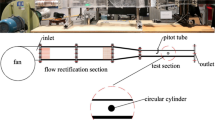Abstract
Turbulence statistics of three impellers with different geometric features were measured using particle image velocimetry inside a Plexiglas model (~1:1 scale) of a cylindrical flame speed vessel (30.5 cm ID × 35.6 cm L). With four impellers arranged in a central-symmetric configuration, turbulence intensities between 1.2 and 1.7 m/s with negligible mean flow (0.1u′) were attained at the lowest fan speeds. Acceptable ranges for homogeneity and isotropy ratios of the velocity fields were set within a narrow bandwidth near unity (0.9–1.1). Homogeneity ratios were unaffected by changes to the impeller geometry, and the prototype with the higher number of blades caused the flow to become anisotropic. The integral length scale of the flow fields varied between 27 and 20 mm, which correlates well with those typically observed inside a gas turbine combustor. The mechanism to independently vary the intensity level and the integral length scale was established, where turbulence intensity level was dependent on the rotational speed of the fan, and the integral length scale decreased with increasing blade pitch angle.









Similar content being viewed by others
References
Abdel-Gayed RG, Al-Khishali KJ, Bradley D (1984) Turbulent burning velocities and flame straining in explosions. Proc R Soc Lond Ser-A 391:393–414
Aldredge RC (1997) On the structure of turbulent premixed flame in high-pressure combustors. Int Comm Heat Mass Transfer 24:565–568
Ames FE, Moffat RJ (1990) Effects of simulated combustor turbulence on boundary layer heat transfer. Heat transfer in turbulent flow. AIAA/ASME Thermophysics and Heat Transfer Conference, Seattle, Washington, pp 18–20
Barringer M (2001) Design and benchmarking of a combustor simulator relevant to gas turbine engines. MS Thesis, Virginia Polytechnic Institute and State University, USA
Birouk M, Chauveau C, Sarh B, Quilgars A, Gökalp I (1996) Turbulence effects on the vaporization of mono component single droplets. Combust Sci Technol 113–114:413–428
Birouk M, Sarh B, Gökalp I (2003) An attempt to realize experimental isotropic turbulence at low Reynolds number. Flow Turbul Combust 70:325–348
Bos WJT, Shao L, Bertoglio JP (2007) Spectral imbalance and the normalized dissipation rate of turbulence. Phys Fluids 19:045101
Bradley D, Haq MZ, Hicks RA, Kitigawa T, Lawes M, Sheppard CGW, Woolley R (2003) Turbulent burning velocity, burned gas distribution, and associated flame surface definition. Combust Flame 133:415–430
Bradley D, Lawes M, Mansour MS (2011) Correlation of turbulent burning velocities of ethanol-air, measured in a fan-stirred bomb up to 1.2 MPa. Combust Flame 158:123–138
Brutscher T, Zarzalis N, Bockhorn H (2002) An experimentally based approach for the space-averaged laminar burning velocity used for modeling premixed turbulent combustion. P Combust Inst 29:1825–1832
Burattini P, Lavoie P, Antonia RA (2005) On the normalized turbulent energy dissipation rate. Phys Fluids 17:098103
de Jong J, Cao L, Woodward SH, Salazar JPLC, Collins LR, Meng H (2009) Dissipation rate estimation from PIV in zero-mean isotropic turbulence. Exp Fluids 46:499–515
Doron P, Bertuccioli L, Katz J, Osborn TR (2001) Turbulence characteristics and dissipation estimates in the coastal ocean bottom boundary layer from PIV data. J Phys Oceanogr 31:2108–2134
Fallon T, Rogers CB (2002) Turbulence-induced preferential concentration of solid particles in microgravity conditions. Exp Fluids 33:233–241
Fansler TD, Groff EG (1990) Turbulence characteristics of a fan-stirred combustion vessel. Combust Flame 80:350–354
Foucault JM, Stanislas M (2002) Some considerations on the accuracy and frequency response of some derivative filters applied to particle image velocimetry vector fields. Meas Sci Technol 13:1058–1071
Goepfert C, Marié JL, Chareyron D, Lance M (2010) Characterization of a system generating a homogeneous isotropic turbulent field by free synthetic jets. Exp Fluids 48:809–822
Gotoh T, Fukayama D, Nakano T (2002) Velocity statistics in homogeneous steady turbulence obtained using a high-resolution direct numerical simulation. Phys Fluids 14:1065–1081
Hwang W, Eaton JK (2004) Creating homogeneous and isotropic turbulence without a mean flow. Exp Fluids 36:444–454
Kim WW, Menon S (2000) Numerical modeling of turbulent premixed flames in the thin-reaction-zones regime. Combust Sci Technol 160:119–150
Kim WW, Menon S, Mongia HC (1999) Large eddy simulation of a gas turbine combustor flow. Combust Sci Technol 143:25–62
Kwon S (1990) Premixed hydrogen/air flames in isotropic turbulence. PhD Dissertation, University of Michigan, USA
Kwon S, Wu MS, Driscoll JF, Faeth GM (1992) Flame surface properties of premixed flames in isotropic turbulence: measurements and numerical simulations. Combust Flame 88:221–238
Leisenheimer B, Leuckel W (1996) Self-generated accelerated confined deflagrative flame fronts. Combust Sci Tech 118:147–164
Lieuwen T, McDonell V, Santavicca D, Sattelmayer T (2008) Burner development and operability issues associated with steady flowing syngas fired combustors. Combust Sci Tech 180:1167–1190
Lipatnikov AN, Chomiak J (2000) Transient and geometrical effects in expanding turbulent flames. Combust Sci Technol 154:75–117
Liu R, Ting DS-K, Rankin GW (2004) On the generation of turbulence with a perforated plate. Exp Therm Fluid Sci 28:307–316
Liu R, Ting DS-K, Checkel MD (2007) Constant reynolds number turbulence downstream of an orificed perforated plate. Exp Therm Fluid Sci 31:897–908
Liu CC, Shy SS, Chen HC, Peng MW (2011) On interaction of centrally-ignited outwardly-propagating premixed flames with fully-developed isotropic turbulence at elevated pressure. P Combust Inst 33:1293–1299
Moss RW (1992) The effects of turbulence length scale on heat transfer. PhD Dissertation, University of Oxford, UK
Nakahara M, Kido H (2008) Study on the turbulent burning velocity of hydrogen mixtures including hydrocarbons. AIAA J 46(7):1569–1575
Pope SB (2000) Turbulent flows. Cambridge University Press, Cambridge
Saarenrinne P, Piirto M (2000) Turbulent kinetic energy dissipation rate estimation from PIV vector fields. Exp Fluids 29(suppl):S300–S307
Sabban L, van Hout R (2011) Measurement of pollen grain dispersal in still air and stationary, near homogeneous, isotropic turbulence. J Aerosol Sci 42:867–882
Semenov ES (1965) Measurement of turbulence characteristics inside a closed volume with artificial turbulence. Combust Explos Shock 1(2):57–62
Shy SS, Lin ML (2000) A new cruciform burner and its turbulence measurements for premixed turbulent combustion study. Exp Therm Fluid Sci 20:105–114
Smallbone A, Tsuneyoshi K, Kitagawa T (2006) Turbulent and stable/unstable laminar burning velocity measurements from outwardly propagating spherical hydrogen-air flames at elevated pressures. J Therm Sci Tech- JPN 1:31–41
Sreenivasan KR (1998) An update on the energy dissipation rate in isotropic turbulence. Phys Fluids 10:528–529
Venkateswaran P, Marshall A, Shin DH, Noble D, Seitzman J, Lieuwen T (2011) Measurements and analysis of turbulent consumption speeds of H2/CO mixtures. Combust Flame 158:1602–1614
Vries JD (2009) A study on spherical expanding flame speeds of methane, ethane and methane/ethane mixtures at elevated pressures. PhD Dissertation, Texas A&M University, USA
Weiß M, Zarzalis N, Suntz R (2008) Experimental study of Markstein number effects on laminar flamelet velocity in turbulent premixed flames. Combust Flame 154:671–691
Acknowledgments
The authors would like to thank Dr. Rodney Bowersox and Dr. R.A.Humble, Department of Aerospace Engineering, Texas A&M University, for providing the PIV system. The financial support from the U.S. Department of Energy through the UTSR grant No. DE-FE0004679 is acknowledged. S.J. Peltier would like to acknowledge the support from the U.S. Air Force Office of Scientific Research.
Author information
Authors and Affiliations
Corresponding author
Rights and permissions
About this article
Cite this article
Ravi, S., Peltier, S.J. & Petersen, E.L. Analysis of the impact of impeller geometry on the turbulent statistics inside a fan-stirred, cylindrical flame speed vessel using PIV. Exp Fluids 54, 1424 (2013). https://doi.org/10.1007/s00348-012-1424-z
Received:
Revised:
Accepted:
Published:
DOI: https://doi.org/10.1007/s00348-012-1424-z




